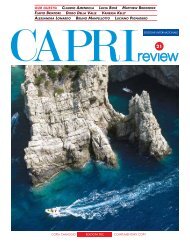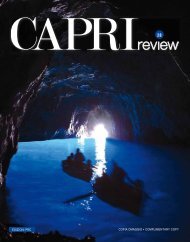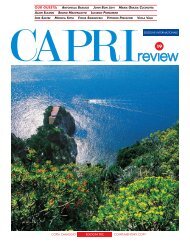Create successful ePaper yourself
Turn your PDF publications into a flip-book with our unique Google optimized e-Paper software.
26<br />
L. GUO<br />
contrario ai troppi medicamenti, introdusse<br />
tra le terapie il regime vegetariano, la dieta,<br />
l’idroterapia, la ginnastica, il digiuno. Ebbe<br />
Cicerone come paziente ed amico.<br />
L’allievo Euforbio fu un esperto botanico,<br />
tanto che Giuba, letterato e protettore<br />
delle arti, volle legarne il nome ad<br />
un genere di piante ancora anonime descritte<br />
dal proprio medico personale in<br />
un trattato: le euforbie, appunto. Euforbio<br />
si chiama ancora oggi il lattice rappreso<br />
estratto dall’Euphorbia resinifera, esclusiva<br />
dei monti dell’Atlante in Marocco.<br />
Antonio Musa si guadagnò la fiducia di<br />
Ottaviano guarendolo prima dai dolori<br />
reumatici con pozioni e dieta vegetariana<br />
e poi da turbe del fegato con l’idroterapia<br />
cara ad Asclepiade, come racconta Svetonio.<br />
Dal futuro imperatore ebbe la massima<br />
considerazione, ricchezze, onori e il<br />
diritto a portare l’anello d’oro pur essendo<br />
solo liberto. Pare che il medico accompagnasse<br />
Ottaviano quando sbarcò per<br />
la prima volta a <strong>Capri</strong> nel <strong>29</strong> a. C. e che<br />
in seguito lo consigliasse circa i punti più<br />
salubri dell’isola dove edificare le sue ville.<br />
Memore degli studi del fratello si sarà forse<br />
appoggiato alla presenza dell’euforbia come<br />
segnale delle plaghe più calde per rifuggire<br />
nella delicata scelta da quelle umide, scongiurando<br />
così una ricaduta di reumatismi<br />
ad Augusto. <br />
two brothers were followers of the school of<br />
Asclepiades, a native of Bithynia who founded<br />
the first schola medicorum in Rome, after<br />
having studied philosophy and medicine in<br />
Greece and in Alexandria. Asclepiades did not<br />
believe in the extensive use of medicaments,<br />
and among the treatments he recommended<br />
were a proper diet – particularly a vegetarian<br />
regime – hydrotherapy, exercise and fasting.<br />
Cicero was both his patient and friend.<br />
His pupil Euphorbus was an expert botanist,<br />
to the extent that Juba, a man of letters and<br />
patron of the arts, wished to link his name<br />
to a then still anonymous genus of plants<br />
described by his physician in a treatise:<br />
Euphorbia, no less. The coagulated latex<br />
extracted from the Euphorbia resinifera,<br />
which only grows on the Atlas Mountains in<br />
Morocco, is still known as Euphorbus today.<br />
Suetonius tells us that Antonius Musa won<br />
M. MASTRORILLO<br />
Ma fiore non è….<br />
Le solari infiorescenze dell’Euphorbia<br />
dendroides sono solo un insieme di foglie<br />
trasformate: per “fiore” un involucro a<br />
coppa o “ciazio” (in greco: coppa di vino)<br />
con vistose ghiandole arancione sul<br />
bordo e al centro un unico fiore femminile<br />
contornato da fiori maschili ridotti<br />
a un solo stame. Alla base due gialle<br />
brattee ovali opposte a simulare i petali.<br />
I ciazi si radunano alla sommità dei rami<br />
giovani in ombrelle a 5-6 raggi, biforcati<br />
all’altezza di un’altra coppia di brattee<br />
gialle. I rami legnosi, anch’essi regolarmente<br />
biforcati, intessono un’impalcatura<br />
arrotondata alta fino a tre metri,<br />
fitta di foglie alterne lanceolate sui rami<br />
giovani, spoglia sul legno vecchio segnato<br />
dalle cicatrici delle foglie cadute.<br />
It’s not a flower …<br />
The sunny inflorescences of Euphorbia<br />
dendroides are simply clusters of leaves<br />
that have changed shape. The so-called<br />
“flower” is like a cup, or ciazio (Greek<br />
for wine goblet) with prominent orange<br />
glands on the rim and a single female<br />
flower in the middle surrounded by male<br />
flowers reduced to a single stamen. At<br />
the base, there are two opposite yellow<br />
oval bracts like petals. The ciazi are<br />
grouped at the tops of the young stems<br />
in umbrellas with 5-6 rays, which are<br />
bifurcate at the point where another<br />
pair of yellow bracts appear. The woody<br />
stems, which are also regularly bifurcate,<br />
form a domed ramification as high as<br />
three metres, whose young stems are<br />
covered with alternate lanceolate leaves<br />
while the old wood is bare and pocked<br />
with the scars of fallen leaves.<br />
Octavian’s trust first by curing his rheumatism<br />
with potions and a vegetarian diet and then<br />
his liver disorders with the hydrotherapy so<br />
favoured by Asclepiades. The physician<br />
enjoyed the future emperor’s esteem, wealth,<br />
honours and the right to wear a gold ring<br />
although he was only a freedman. It appears<br />
that Musa accompanied Octavian when<br />
he first landed on <strong>Capri</strong> in <strong>29</strong> BC, and later<br />
indicated to the emperor the most salubrious<br />
sites on which to build his villas. Basing<br />
himself on his brother’s studies, he perhaps<br />
considered the presence of Euphorbia as an<br />
indication of the warmer parts and avoided the<br />
damper areas, thus preventing a recurrence<br />
of the emperor’s rheumatism.







